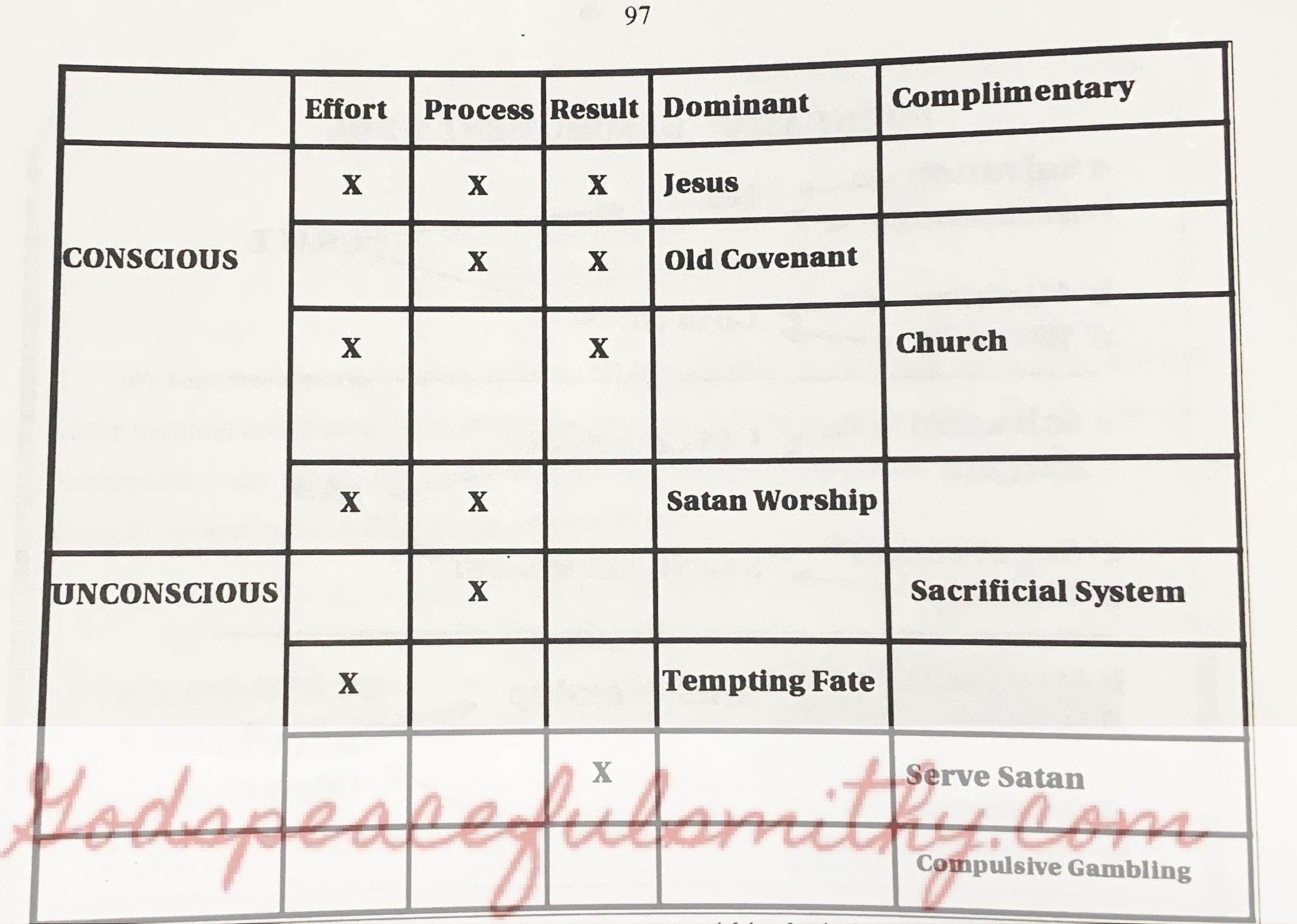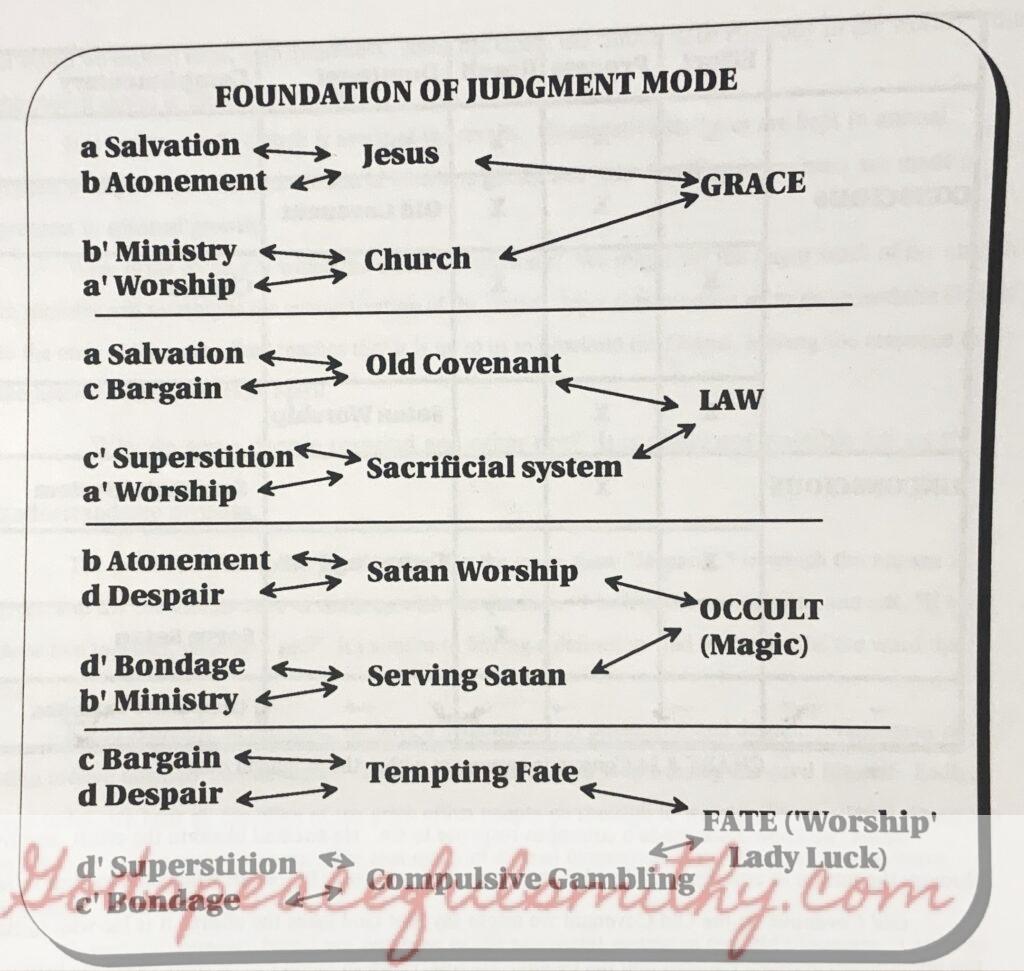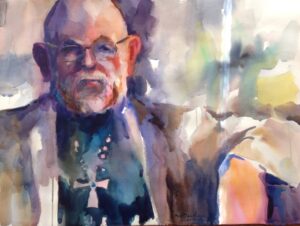
Judgment Mode is the third post in the series of Religious Modes. If you landed here first you may want to go back to the first post:The Security Mode.
Am I-syn-anti
As with the other Religious Modes I am following Walter Lowen’s concept of “Ambi-syn-anti” to develop my reasoning. Also this depends upon his understanding of entropy with levels of consciousness.
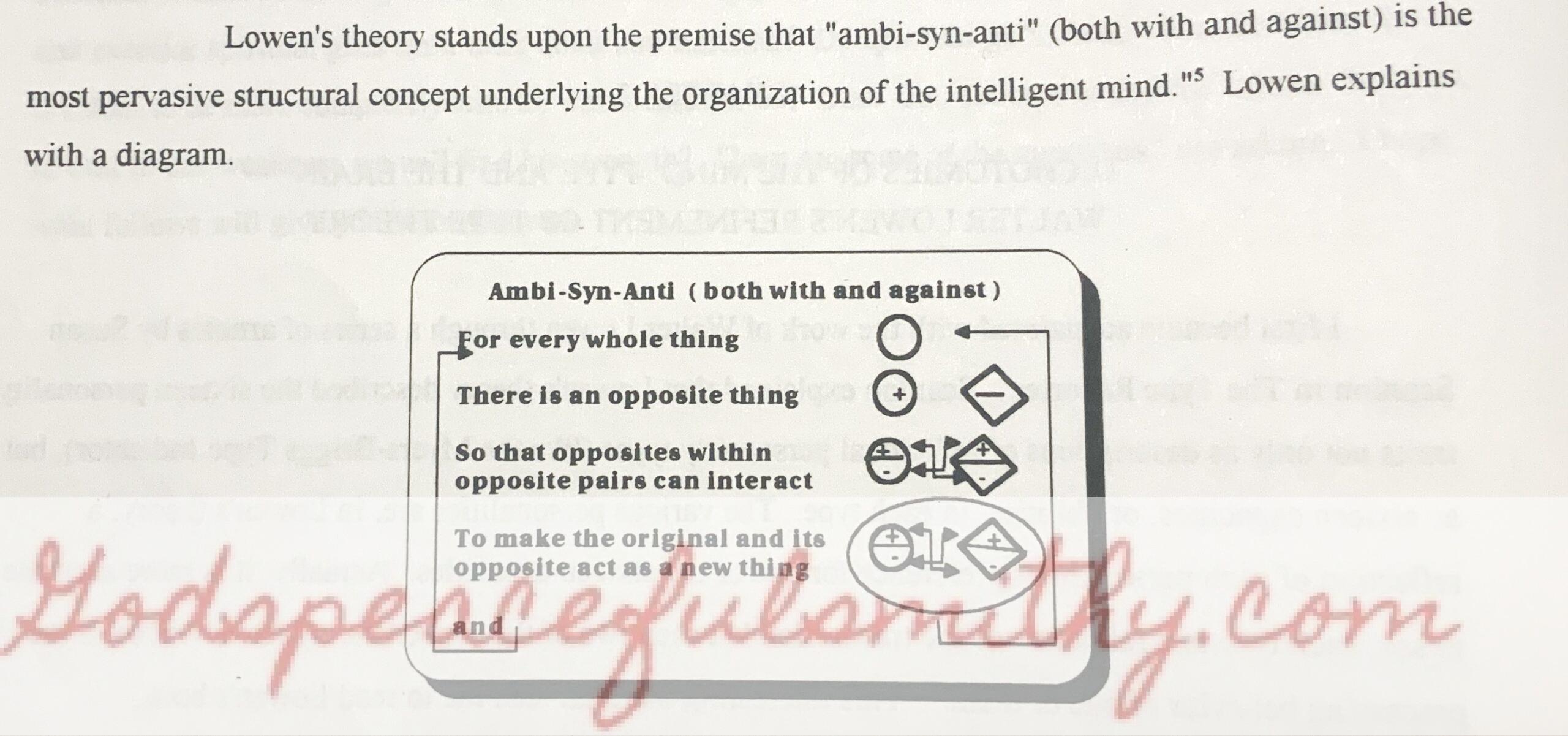
So here are the new variations of the previous post in the series. In the first chart we have Responses to sin. On the other side, Responses of awareness of God. As before when we are able to shift in a positive direction on the left we also shift in a positive on the right. Of course the negative shift works the same way.
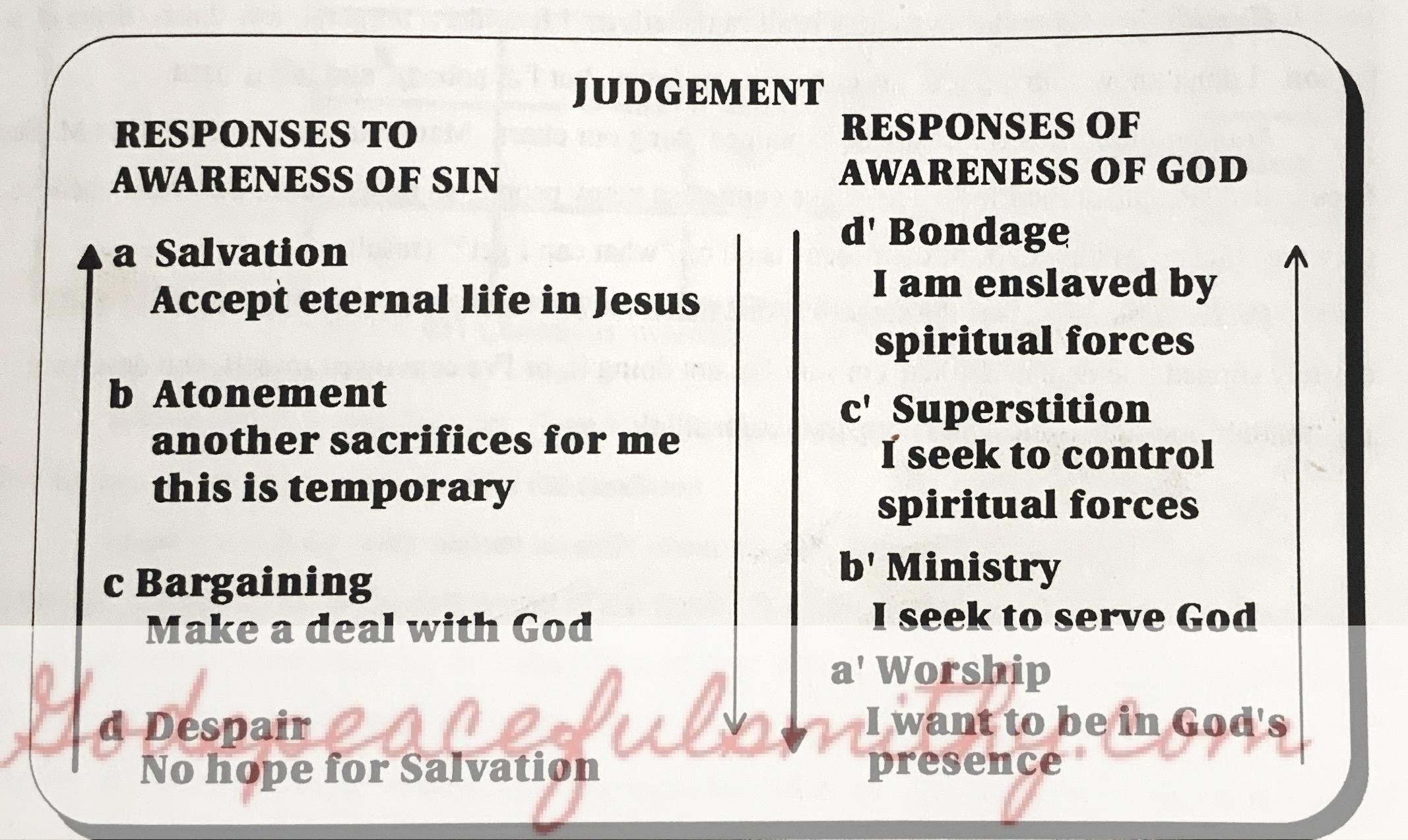
When we combine in an Ambi-syn-anti manner we get the results of the second chart. Then looking at the third chart the x marks how we are aware of Effort, Process, and Result.
Explanation of Judgment Mode
Jesus: we know Jesus made a conscious response to sin. He sweats blood in the effort, and lives through the torture of crucifixion. Then he rose in victorious result to free all who come to him in faith.
Old Covenant: in the Old Covenant, we might say that God takes the effort. It is He who initiates the relationship between himself and the people. He intervenes in history to be their God. He brings them out of bondage in Egypt. The people of the covenant have an awareness of the process. They celebrate it each year. At Passover, they recite the history. They are likewise aware of the result. They are the chosen people.
Church: as I look at the chart, I remind myself, that it is an expression of awareness of, and not the effort, process, and results themselves. For every behavior, we are discussing, there is effort, process, and result. The variable is the awareness. We now ask, how was the church aware of the effort?
I have said the church is the result of a combination of worship and ministry. Its parallel is not the Old Covenant, but rather the sacrificial worship system. Worship is the work of the people and ministry is also something in which we expand effort with awareness. Jesus has called the church to be His body in the world; plus the church shares in the work of Jesus.
It is easy to see the church is aware of the results. Quantitative statistics are kept in annual reports, Baptisms, confirmations, and of members gained and lost. Qualitative analysis are made of progress in spiritual growth.
What is the process of which the church is unaware? We might see the major work of the church in Ministry and Worship is the evangelization of the world. Jesus commissions us to spread the Gospel to the ends of the Earth. Paul teaches that it is up to us to proclaim the Gospel, leaving the response to the listeners, and to the Holy Spirit.
Why do some people respond and others not? It is really not possible for us to understand the process.
The procedure I am following is rather like the game show Jeopardy in which the answer is given and the contestants have to come up with a question. I look at the transactions and ask if I put these two together, What do I get? It is similar to having a definition, and trying to find the word that fits.
Satan Worship: in this case, we have a combination of atonement and despair. Atonement is often broken down, as at-one-ment. To be at one with the despair, is to worship the devil himself. Sadly, even today, we hear all too often of the great effort people go through to worship Satan. The rituals are an intricate and complex process. The real result of eternal damnation is hidden from their present awareness.
Sacrificial System: here I am speaking of the sacrificial system of the Old Covenant . I am also thinking of any religious activity today that might operate in the same manner. One idea behind this theoretical analysis is to raise to consciousness the ways in which we slip into these Christian modes, ( religious, security, judgment, and justification), or use them in the process of gradual awakening to Conversion.
The sacrificial system of the temple was an involved process with lots of rituals and regulations. The priests were trained to be conscious of them all.
In this section, I have taken superstition and added it to worship. What do I have? It is the superstitious behavior that eludes awareness of effort. Think of it in Lowen’s explanation of perseverance. We have perseverance, says Lowen, when we are unaware of the effort, (He uses the example of a hobby), the priest of the temple persevered. Indeed, even now, there are priests who work tirelessly to be prepared should the temple be rebuilt!
Paul argues against the Judaizers who are leading the church toward Old Covenant worship and return to the Law. It is easy to see how some Christians today slip into what might be considered superstitious behavior in worship.
I like seasons and special days. I like the outward expressions of signs and symbols. There are times when I genuflect , and times when I cross myself. Yet, I try to be clear to myself that these are a kind of nonverbal prayer, rather than superstitious behavior to ward off evil.
Tempting fate, this is a process that occurs more frequently than one might think. Our culture is full of all kinds of Dare Devils. In the South, where I live, people by the thousands idolize race car drivers. These men, and a few women, expend plenty of energy to drive in the fast lane, and live on the edge. Oh, they might think they are aware of the process: how to drive the car- steer, brake, turn, pass. Etc. However, they are unaware of the real process, tempting fate!
When the unconscious result comes – when the car crashes, the body is broken, or killed, they incredulously wonder, “Why did this have to happen!” It is as if one could jump off the highest pinnacle of the temple and not die at the bottom.
Serving Satan: consciously, this is the opposite of tempting fate. Tempting fate has conscious effort with unconscious results. Serving Satan has conscious results with unconscious effort. Maybe the results are clear at the beginning, but the end result does eventually come to full awareness. There is Hell to pay! Without effort we can fall into temptation. We slip into the process. It is like the teenager who says, “Gee, Dad, I don’t know how it happened! One minute all was fine and the next I was here in jail!”
Compulsive Gambling: this is like addiction in general, from our last consciousness chart. Serving “Lady Luck,” playing the horses and the stock market, or your gamble of choice, is full of denial and unconscious behavior. Most gamblers won’t even admit to addiction. “It’s not luck, I have a system!” Superstitious behavior, combined with bondage is a good definition for compulsive gambling.
Summary
I have followed Lowen’s example and pushed the defining process to the next level. The result is in for clear religious modes: grace, law, occult, and fear. These parallel Lowen’s categories of work, play, challenge, and creativity. It will be interesting to see how in each personality type, there is a greater temptation to slip into law, occult, and fear and the corresponding areas of consciousness. For example, do I, as a ENFJ look to grace in my work mode as a verbalist/perceiver? Do I resort to law in my play mode as an Analyst/suspect or? Do I engage in superstitious behavior in my challenge mode of classifier/doer? Am I vulnerable to fatalism in my creative mode of organizer/molder?
Perhaps this is true for me. I do make a conscious effort at work to preach and teach in word and dependence upon the grace of God. I am aware when others slip into law oriented behavior. I strive to keep the congregation in tune, with the Gospel of grace, God’s riches, at Christ expense.
The theory holds true in the totality of my life. My play mode is very much the analyst/suspector. I have worked playfully at this present analysis and theoretical detective work. With the perseverance, that surprised me, until I realized it was, indeed, my play mode. Yes, I admit there is a temptation to law, the judgment modes, equivalent of the play mode, involved in this process. This is certainly true in the sense of wanting everything to fit into an orderly schema.
Turning to the concept of law is true in another play activity of mine involving analysis, and suspector skills: Chess. My approach to the game is to discover the underlying principles of play. Then, I apply them relentlessly in each game. For example, I say to myself in the opening game, “Make as few pawn moves as possible. Develop the pieces and, if possible, never move the same one twice until the middle game. Control of the center of the board. Never attack, unless you are even or greater in power, etc.”
According to Lowen, tennis and another physical activities are what fall into the challenge mode of ENFJ. The process of such activity is unconscious to me. In fact, if I try to pay attention to what I am doing by focusing too much on the specific parts of the game, I get worse, not Better. Instead, I tend to engage in superstitious behavior. I wear the same clothes. I bounce the ball twice, not once or three times, but twice before serving, etc.
The creative mode for NFJ is involved with fine motor, and hand eye coordination. In my life, this is connected with playing musical instruments and doing arts and crafts like Origami. The judgment mode, suggests that I will become involved with these activities in an unplanned, fatalistic, or providential matter. One example is clear case of my openess to fatein this area. One day, my wife and I went to buy vacuum cleaner bags at the catalog store. They didn’t have them, but they were selling out their musical instrument department. So I bought a banjo. I could think of several other examples that make me suspect the connection is valid.
Go to the next post in this series by clicking here.
